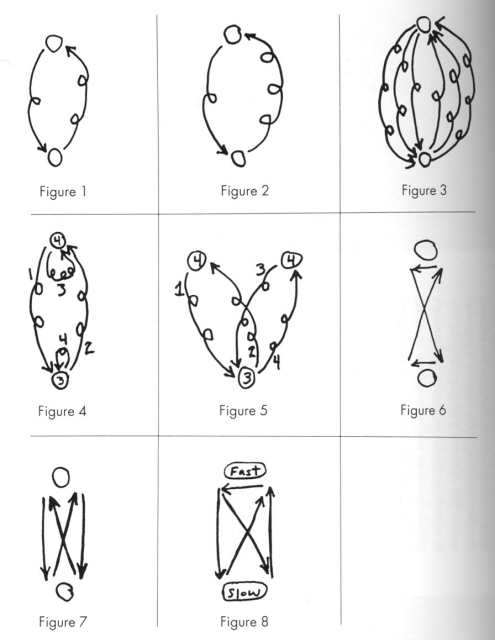 |
Page 28 Spring 1991
|
JUGGLER'S
WORKSHOP
SEVEN CLUB PASSING Copyright
1991 by Martin Frost Are you a seven-club passer? If you're not, read on for some techniques for mastering seven, and if you are, read further for some variations on the theme. There are many ways to pass seven clubs, some of which can be turned nicely into different 11-club feeds. LEARNING
TO PASS
SEVEN DOUBLES The
common way for two people to pass seven clubs is passing every right
hand club (that is, a 2-count) with double spins. Since seven is an
odd number, the two jugglers are passing at different times. One
person starts with four clubs and throws the first double (pass),
then one count later the other juggler responds with a return
double.
When
learning something new like seven clubs, you can make it easier by
practicing the parts individually before putting the whole thing
together. So in this case, each partner should practice throwing
doubles with the right hand. Just pass one club around with double
spins.
When
throwing a double, don't spin it faster than a single, just throw it
higher - high enough
so that there's enough time for a normally spinning club to spin
twice. This will help to keep your seven-club pattern relatively
slow and controllable. To keep the spin slow like this, always throw
the club from the knob. Your hand should be wrapped around the
handle but making contact with the knob.
Also,
learn to make the throw from just outside your right leg, not in
front of it. This will make your pass go straight across to your
partner, rather than slanting toward the outside, and that will make
it easier to throw accurately to just outside your partner's
shoulder.
Next
add one more club and pass the two around with doubles, one right
behind the other. As you get better at throwing good doubles, keep
adding one more club at a time, passing doubles in a group (followed
by several holes in the seven-club pattern). As you pass these
clubs, you should certainly try to keep them all peaking at the same
height, so that they're good
doubles. But also try to glance over at your partner now and then as
one of your throws lands. This gives you important feedback on how
good or bad your throws are.
When
you finally get to passing all seven clubs, continue to try to look
at your partner's catches whenever you can. You may find it tricky
at first to find enough time to look over there, but it can be done
and is very important, in this and in harder patterns. The more
consistent your partner's throws are to you, the easier it is to
see your throws caught, and the more you do that, the more
consistent your throws will be.
One
final thing, remember to keep your doubles high. The most common
problem is low doubles that haven't had time enough to spin twice,
and low doubles make the whole pattern faster and much harder to
learn.
SEVEN
SINGLES AND
DOUBLES The
seven-club pattern that most passers try to master after seven doubles
is seven singles, with all the passes being singles instead of
doubles. The problem with seven singles is that it is much faster than
seven doubles, and hence hard to learn.
An
easier pattern to pick up before seven singles is seven singles and
doubles, a compromise between all singles and all doubles. In this
pattern, one person passes all doubles and the other passes all
singles (Fig. 1). This makes it somewhat faster than seven doubles but
not as fast as singles. Don't be confused by the fact that the two
people are now making different height throws. The doubles should
still be as high as before, and the singles should be normal singles.
Have the person who is passing doubles start first, with four clubs. The second juggler should wait just slightly longer before starting than you would in seven doubles. Be sure to switch off the roles from time to time. |
 |